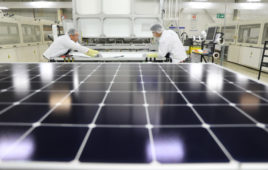Tuscon Electric Power’s 15-MW Raptor Ridge solar array was commissioned this month at a 100-acre site in Tucson, Arizona. The community solar project uses Solar FlexRack’s single-axis trackers to support 35,500 bifacial modules, which increase energy production by up to 30%.
Credit: Solar FlexRack
The new array will supply power for the TEP GoSolar Home program, which provides a renewable energy option for renters and homeowners, including those whose rooftops are shaded by trees or nearby buildings.
“We selected Solar FlexRack from many solar racking options because of their engineering expertise and solar tracker architecture with minimal backside shading design, well suited for bifacial modules,” said Jeff Krauss, manager of community-scale renewable resources at TEP. “In a challenging market environment where supply chain issues have delayed other large solar projects, Solar FlexRack demonstrated their commitment to customer service by honoring agreements and delivering product on time. We are excited to bring this community-scale solar project online and Solar FlexRack is a big part of TEP’s success at Raptor Ridge.”
For businesses and homes that cannot host rooftop solar, the U.S. community solar market continues to grow and enable greater access to solar energy, with expectations that it will add more than 4.5 GW of total capacity over the next five years.
“We are pleased to have been selected by Tucson Electric Power to participate in this benchmark project,” said Mike Herman, director of operations at Solar FlexRack. “We look forward to providing our engineering expertise and reliable and time-tested trackers in additional impactful community solar projects in 2022 and the years to come.”
News item from Solar FlexRack





A solar PV farm with an average of 150kWp per acre. With the bifacial solar PV on a single axis tracker one could get something like 8 hours of solar PV harvest a day in Winter and from 10 to 12 hours a day solar PV harvest in the Summer. Now all this site needs is about 120MWh a day to 180MWh a day. This site could use a long term stoarge system like the one (just) announced in Italy that takes CO2 and can store energy for 10 hours, build two of these and one can stagger the operations and have 20 hours of energy storage. Designing an ESS to take 33% of the daily energy generated would represent a low of about 40MWh in the Winter to 60MWh in the Summer months.